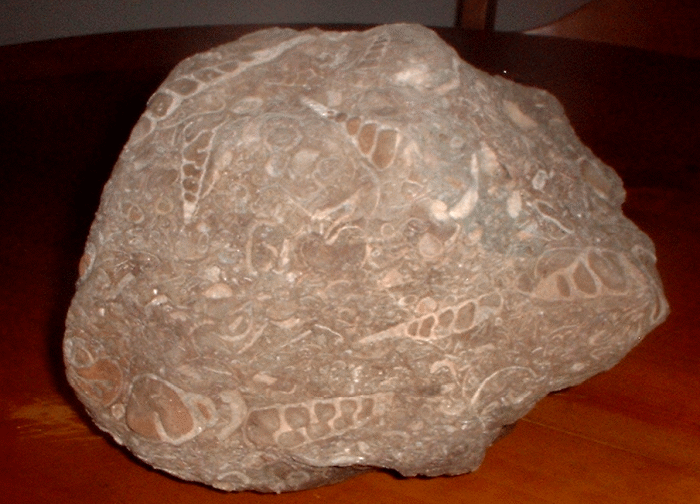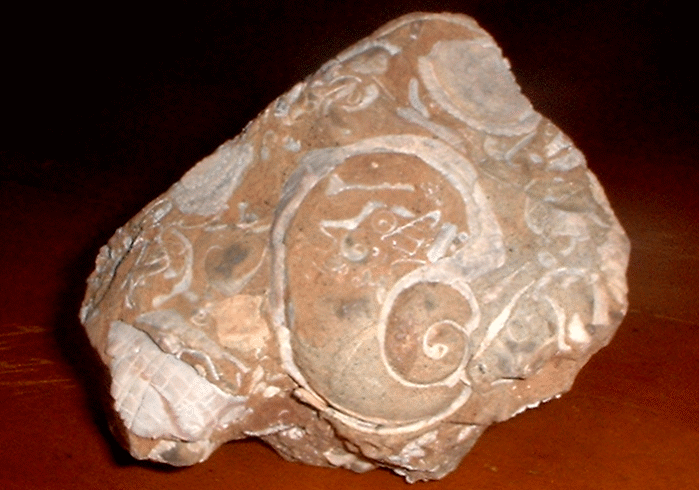|
Mystery Fossils
|
| |
|
Data:
I found these fossils in Thousand Oaks, California about 6 years ago
in the hills between TO and Simi Valley high up on the top of the hill.
The
large rock (1) is about 15 pounds and is 10" x 8", and is
7" tall. The smaller one (2) is about 3 pounds, is 5" x 3
& a half inches, and is 2" tall.
They
were sticking out of a trail wall (obviously someone had a tractor up
there to make a fire break, and they left a 'wall' on the side where
they plowed) and it didn't take much to get them out.
Much
more than that I do not know. I found them and brought them home, and
now I am going to show them in the fair.
I
plan on showing them in the fair this year, as they go in 3 weeks from
now, and it is mandatory that the exhibitor put the genus name down
along with the common name (neither of which I know!).
I really appreciate any help that is given to me!
Send
Ideas to:
Diane
|

1.
Identified:
- almost exclusively
Turritella peninsularis Anderson & Hanna, 1935
see NOTE
|
|
Question
#1: What is the difference between Turritella ocoyana & Turritella
andersoni? Both are spiral shells...Diane
Answer:
- First and
foremost the three species are different ages: Turritella peninsularis
[Paleocene, ca 60 mybp], T. andersoni [Eocene, ca. 50
mybp], and T. ocoyana [Miocene, ca. 15-16 mybp] and since
the formation is Paleocene in age your specimens are T. peninsularis.
Obviously, there is an advantage to knowing the proverbial territory
(ie., the geology of southern California).
Regarding comparisons, see the following web site for what several
living species of turritellas look like www.seashellcity.com/seashells/turritellashells.html
(I have absolutely no affiliations to this business site …
it just happened to show several different species for comparison
sake).
Both T. peninsularis and T. ocoyana are larger and
heavier species than T. andersoni and both have a greater
‘plural angle’ than in T. andersoni. This is the
angle formed if you laid the specimen on a piece of paper and drew
lines along each shell margin from the apex (the spiral tip) towards
the apertural end. Turritella andersoni and its related species
and subspecies are all much slimmer so to speak that the other two
species.
Aside from the age difference, T. peninsularis and T.
ocoyana look very similar but T. ocoyana has much more
bold spiral sculpture (ie., the lines that spiral around the shell
from the apex to the aperture) than does T. peninsularis.
If specimens are poorly preserved such as yours, we must rely on
our knowledge of what species are found in what formations and make
comparisons and yes … sometimes simply guess....Lindsey
Discussions:
-
May be -Turritella
andersoni ? See: Gastropods
from California ...Avril B.
-
Top photo is Turretella.
Have fun... Jack D.
-
The shells in the
larger rock are Turritella sp. For some reason, Turritella
shells are often fossilized in huge masses, and the hard rock containing
such masses are often referred to as "turritella agate"...
Paul M.
-
Actually, standard
"Turritella agate" contains Eocene Juga spp., freshwater
pleurocerids from the Green River Formation in Colorado and
Wyoming. "Turritella" is a misnomer in that case.
However,
the present specimens come from not far from the modern California
coast and probably represent actual turritellids. There's a
fair amount of research that has been done on the fossils of
the general region. The California Geological Survey website
would probably be a good source of information, or a geology
department at a nearby college...Dr. David C.
-
These
specimens are all from the Paleocene (ca. 60 mybp) Santa Susana
Formation of the Simi Hills, Ventura County, California. Image
1 is almost exclusively Turritella peninsularis Anderson & Hanna,
1935. Image 2 contains Gyrodes robustus Waring, 1917 (the
large naticid or moon snail), some small T. peninsularis, an oyster
fragment, and a fragment of the large bivalve Venericardia sp.
FYI, in certain outcrops the fine-grained mudstone/ siltstone nature
of the matrix of this formation is like concrete, hence the fossils
contained are usually very worn and virtually impossible to extract
whole. Hope this information help...
Aloha,...Lindsey
|
|

2.
- Gyrodes robustus
Waring, 1917 (the large naticid or moon snail), some small T. peninsularis,
an oyster fragment, and a fragment of the large bivalve Venericardia
sp. See NOTE
|
Question
#2. What is the difference between Polinices recluzianus & Polinices
sp. cf. P. lewisii?
I did some research on these, and on #2. it almost looks as though
the Polinices recluzianus is not necessarily a fossil, but I could
be way off on that. It's just when I looked it up under the web search
of 'polinices recluzianus', both of the ones on #2 are shown, and
it talks about both of them, but has photos of living ones for the
recluzianus, and fossil ones of lewisii. It also says that recluzianus
is found no farther north than Ventura County, which is the county
that I live in...Diane
Answer:
Regarding
the differences between Gyrodes robustus and Polinices
recluzianus and Polinices sp. cf. lewisii once again
it is imperative that someone knows the territory.
First, Polinices reclusiana had yet to appear in the fossil
record in California in the Paleocene so obviously it couldn’t
be that species. FYI it ranges from late Eocene (ca. 40 mybp) to Recent.
The same goes for P. lewisii as it ranges from late Miocene
(ca. 6 mybp) to Recent. Not to confuse the issue further but those
two species have been reassigned to different genera … Polinices
recluzianus now is Glossaulax reclusiana and Polinices
sp. cf. lewisii now is Euspira lewisii. (when collectors
or researchers use ‘sp.’ and/or ‘cf.’ it means
that they are uncertain as to the species identification hence the
use of ‘sp.’ and ‘cf.’ when they think it may
be that species but cannot be sure.)
As far as physical differences between the genera Gyrodes is usually
has a much lower spire than Polinices and has channeled suture area
whereas Polinices does not. The suture is the line where each spiral
of the shell joins itself when completing each revolution. With most
moon snails this is a smooth feature whereas in Gyrodes this line
is like a shallow furrow around each revolution....Lindsey
-
any possibility of
this being an ammonite?
See: http://www.sdnhm.org/fieldguide/fossils/ammonite.html
OR - Polinices sp. cf. P. lewisii (Lewis' moon snail)
See: http://www.sdnhm.org/fieldguide/fossils/lmoonsnail.html
OR - Bellerophon hilli ? See: Gastropods
from California
Avril B.
-
moon snail. Have
fun. Jack D.
-
The main shell in
the smaller rock appears to be a naticid (moon snail), but I can't
rule out a trochid (top shell)... Paul M.
-
These
specimens are all from the Paleocene (ca. 60 mybp) Santa Susana
Formation of the Simi Hills, Ventura County, California. Image 1
is almost exclusively Turritella peninsularis Anderson &
Hanna, 1935. Image 2 contains Gyrodes robustus
Waring, 1917 (the large naticid or moon snail), some small T. peninsularis,
an oyster fragment, and a fragment of the large bivalve Venericardia
sp.
FYI, in certain outcrops the fine-grained mudstone/ siltstone nature
of the matrix of this formation is like concrete, hence the
fossils contained are usually very worn and virtually impossible
to extract whole. Hope this information help
Aloha,...Lindsey
|

